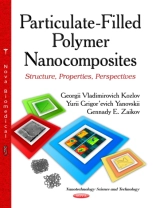The present monography consists of three parts, in which particulate-filled polymer nanocomposites with elastomeric, semicrystalline and amorphous glassy matrices, and also hybrid nanocomposites, were considered. The relationship structure-properties study for all the indicated above nanocomposites were performed on the basis of modern physical conceptions-fractal analysis, percolation theory, cluster model of polymer amorphous state structure and synergetics of the solid body. Particular attention is paid to the basic effects found for nanocomposites: interfacial adhesion and nanofiller particles aggregation. A number of new typical effects for polymer nanocomposites (for example, the nanoadhesion effect) are described in detail. A new treatment of the nanocomposites structure reinforcing element is offered as the sum of the nanofiller and interfacial regions contents, taking into account the interfacial adhesion level. This has allowed us to use the modified percolation model for the determination of these materials reinforcement degree, as well as an evaluation of its greatest reaching value. An important role of nanoparticles (aggregates of nanoparticles) in nanocomposites properties formation has been shown. For the initial nanoparticles aggregation degree, a theoretical model within the framework of dispersive strength theory was proposed, allowing one to perform nanoparticles aggregates size estimation as a function of their contents. With the aid of nanoindentation, the interfacial layer sizes and elasticity modulus were experimentally determined. Within the framework of the indicated above fractal models nanocomposites thermophysical properties, their electrical conductivity and other properties were studied. It has been shown that the classical continuous models, developed for polymer microcomposites, do not give an adequate description of change (reduction) of polymer nanocomposites melt viscosity at the nanofiller contents enhancement. Such a description can be obtained by the fractally-beaten ice model application.
Format PDF ● Pages 283 ● ISBN 9781629482163 ● Editor Georgii Vladimirovich Kozlov & Yurii Grigor’evich Yanovskii ● Publisher Nova Science Publishers ● Published 2013 ● Downloadable 3 times ● Currency EUR ● ID 7223708 ● Copy protection Adobe DRM
Requires a DRM capable ebook reader












